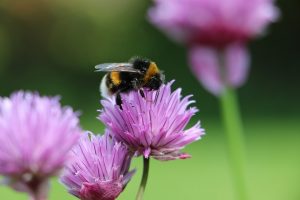
image from Pixabay user kimgreenhalgh90
As summer starts to come to an end, gardening starts to leave our minds as we make room for fall and winter. For those that want to support pollinators to the best of their ability, it is good to remember that there are still species around in late summer, and early fall, who need habitat and floral resources to be able to make a new generation of pollinators. Here are some tips on providing for late season pollinators in your landscape.
Just like any living thing, pollinators need food, water, shelter, and space to thrive.
Most native bee species in Colorado are ground nesting. This means that they dig into the soil and nest under the surface. To encourage nesting in your landscape, provide sunny, undisturbed ground in your garden that is free of mulch and plant material. You also don’t want these areas covered in landscape fabric or weed barrier.
Some native bees nest in hollow stems and tunnels. You can leave your perennials untrimmed until spring and leave dead wood snags as well.
Butterflies like open sunny areas, but also need protection from wind. Windbreak plantings or other ways of sheltering an open area will encourage them to stick around your yard.
Pollinators also need water. You can provide a dish filled with pebbles and water so they can land and get a drink. You should dump and replace the water every couple of days to prevent mosquitoes from breeding in it.
Bees will also drink water from drip systems, sprinkler heads, fountains, and bird baths, so be sure not to use pesticides near these water sources to avoid poisoning our pollinator friends.
Male butterflies tend to congregate on moist sand or mud around puddles of water. Female butterflies will be in search of the proper host plant for their caterpillars, so they can lay eggs on it. T
Perhaps the most important thing you can do to support late season pollinators in your garden is to have floral resources for them. Early season plants are very important, most all of us have plenty of flowers in the middle of the season, but it is also important to make sure you have a few species that bloom later in the season as well. Below is a list of late season bloomers that you can incorporate into your landscape:
- Rocky Mountain bee plant – Cleome serrulata
- Common sunflower – Helianthus annuus
- Goldenrod – Solidago
- Rabbitbrush – Chrysothamnus nauseosus
- Plains Coreopsis – Coreopsis tinctoria
- Hairy False Goldenaster – Heterotheca villosa
- Tansy Aster- Machaeranthera canescens
- Chokecherry – Prunus virginiana
- Boulder raspberry – Rubus deliciosus
It is best to plant these species together in clumps, that way bees and butterflies don’t have to waste as much energy flying across your yard to get to them. Also, don’t forget that pesticides can be deadly to pollinators, so use other IPM methods to control any pest issues in your garden.


